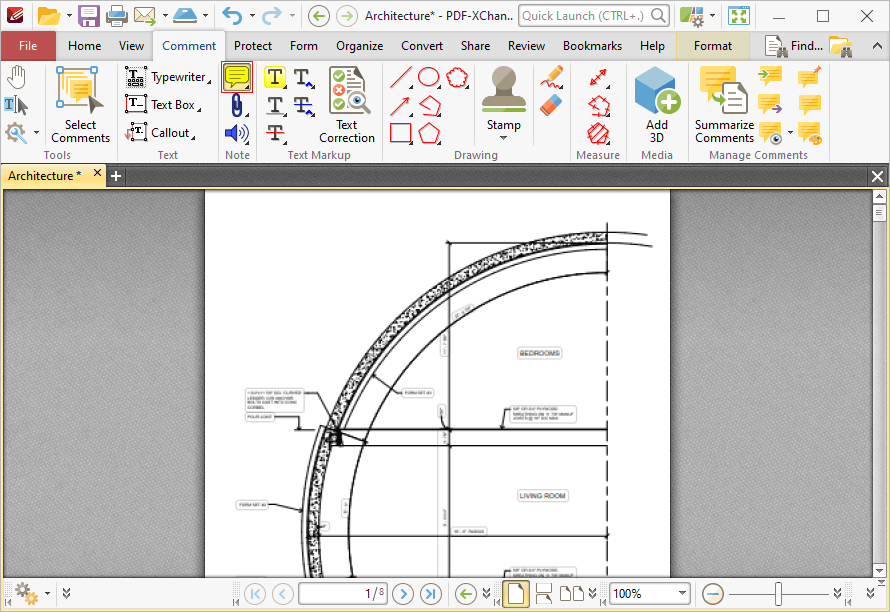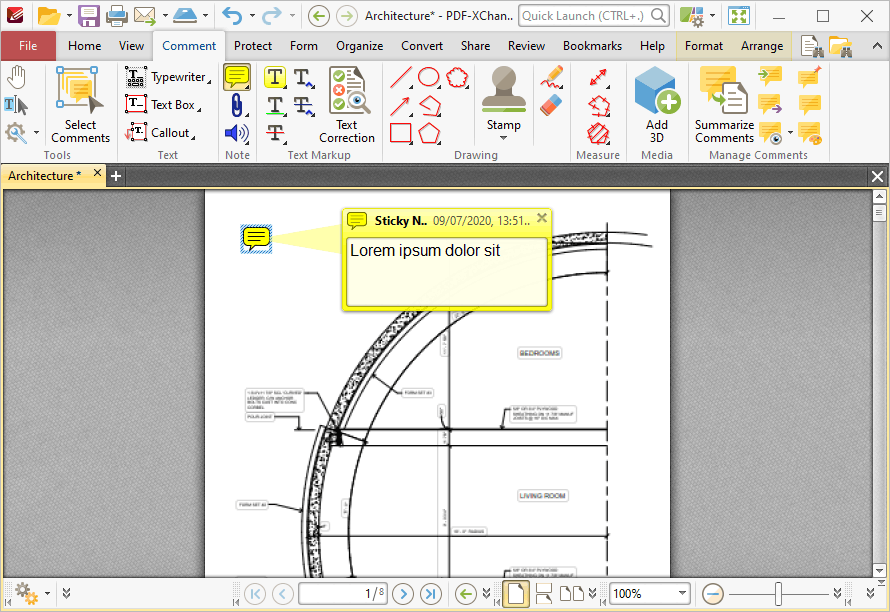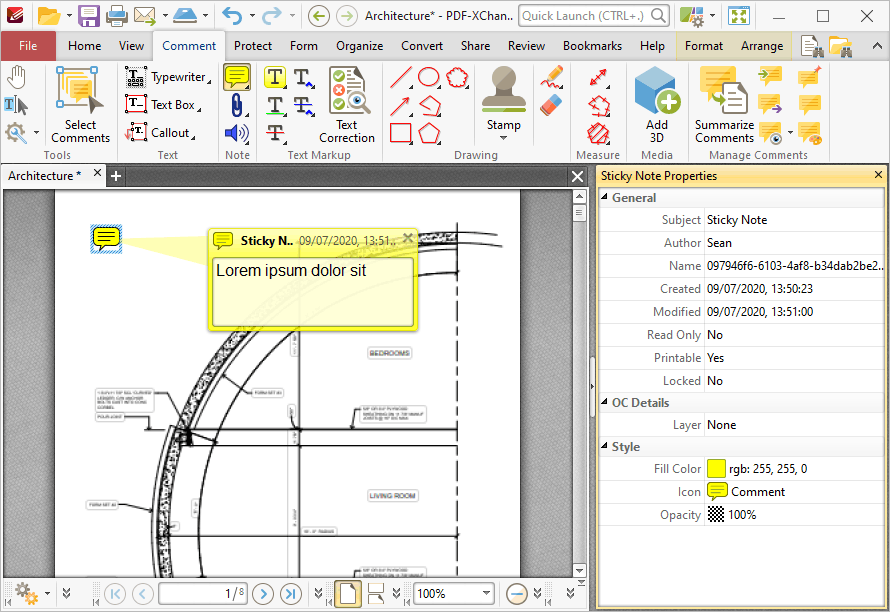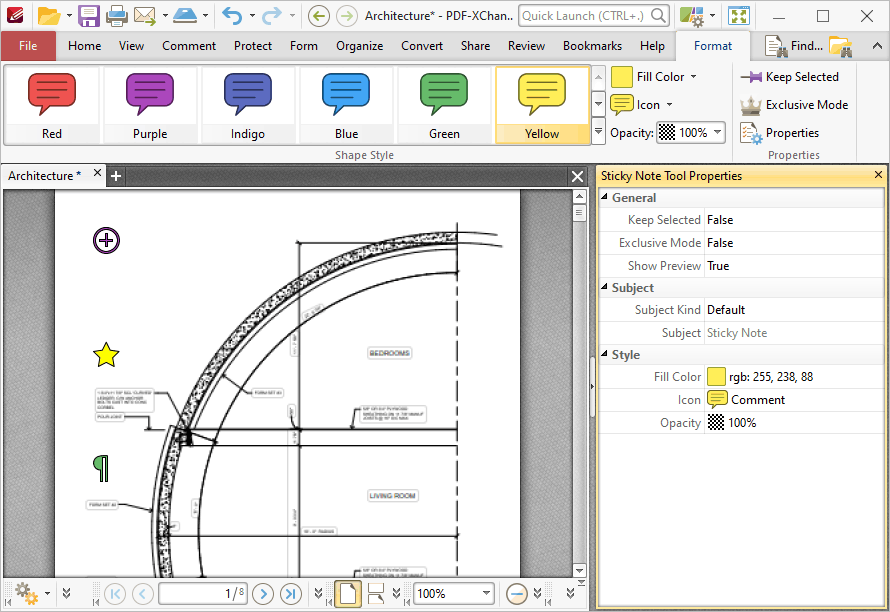 Sticky Note Tool
Sticky Note Tool
Click Sticky Note to add sticky note comments to documents:

Figure 1. Comment Pane, Sticky Note Tool
Sticky note comments enable the storage of text notes. The text in sticky note comments is contained in a collapsable text box that can be expanded as required. When the text box is collapsed, only the sticky note icon remains in the document. This means that large text notes can be stored in documents without taking up excessive space. If the pointer is hovered over the sticky note icon subsequently, then the note content will be displayed in the same manner as a tooltip.
When the Sticky Note Tool is enabled, click to add sticky notes:

Figure 2. Sticky Note Tool Example
•Click and drag the sticky note to reposition it.
•Enter the desired note content within the associated pop-up note text box. This content will be displayed when the pointer is hovered over the icon subsequently. Right-click when entering/editing text to launch the text editing options menu. These options are explained here.
•Use the arrow keys to reposition sticky notes. Hold down Shift to move at an increased increment.
•Right-click sticky notes for further options. See here for an explanation of these options.
•Press Ctrl+' to open the Properties pane for selected sticky note comments and view/edit properties:

Figure 3. Sticky Note Tool, Sticky Note Properties Pane
•Subject is the name of the sticky note comment, as referenced in the Comments pane.
•Author is the name of the user that created the sticky note comment.
•Name is the unique name of the sticky note comment, as referenced within the application.
•Created is the date and time at which the sticky note comment was created.
•Modified is the date and time at which the sticky note comment was last modified.
•Read Only is the read only status of the sticky note comment. If this property is enabled then users cannot interact with the comment. Please note that it is necessary to use JavaScript to change the value of this property.
•Printable is the print status of the sticky note comment. If this property is enabled then the comment is printed with the document. If this property is not enabled then the comment is not printed.
•Locked is the locked status of the sticky note comment. If this property is enabled then the comment cannot be deleted and its properties (including its position and size) cannot be modified by users.
•Layer specifies the optional content layer to which the sticky note comment belongs. Further information about layers is available here.
•Fill Color determines the color of the sticky note comment.
•Icon determines the icon used for the sticky note comment.
•Opacity determines the level of transparency in the sticky note comment.
Note that when the Sticky Note Tool is enabled, the Format tab is available and can be used to customize the default properties of sticky notes:

Figure 4. Format Tab, Sticky Note Tool
•Click options in the Shape Style group to select alternative default sticky note styles.
•Click Keep Selected to keep the Sticky Note Tool enabled and add multiple sticky notes to the document. If this option is not enabled then PDF-XChange Editor will revert to the designated default tool immediately after creating one sticky note.
•Click Exclusive Mode to enable exclusive mode, which simplifies the process of using the Sticky Note Tool. When Exclusive Mode is enabled, the pointer ignores all interactive elements of documents other than base content. This makes it possible to create sticky notes on areas that overlap with other content without the risk of accidentally selecting undesired items. When Exclusive Mode is disabled, the pointer recognizes and interacts with all underlying elements in the usual manner.
•Click Properties to open the Properties pane and view/edit sticky note properties, as detailed above.
•When sticky note comments are selected, the Style Tools dropdown menu is available in the Format tab. It contains the following options:
•Click Copy Comment Style to copy the style properties of comments.
•Click Apply Copied Comment Style to apply a copied comment style to selected comments, including the text properties.
•Click Apply Copied Comment Appearance to apply copied comment styles to selected comments.
•Click Apply Copied Text Style to apply copied text styles to selected comments.
•Click Make Current Properties Default to set the properties of the selected comment as the default properties for subsequent comments.
•Click Apply Default Properties to apply the default comment properties to selected comments.
•Click Make Current Text Format Default to set the text format of selected comments as the default format for subsequent comments.
•Click Apply Default Text Format to apply the default text format to the text of selected comments.
•When sticky note comments are selected, the Pop-up group is available in the Format tab and can be used to interact with the pop-up note of the comment:
•Click Open to open the pop-up note.
•Click Hide to hide the pop-up note.
•Click Reset Location to reset the location of the pop-up note.
•When sticky note comments are selected, the Arrange tab is also available and can be used to manipulate comments as detailed here.
Note that the Comment Styles Palette can be used to edit and save customized sticky note styles for subsequent use, and the Commenting preferences can be used to view/edit preferences for all comments.
Note that to select text in an annotation after it has been completed, it is necessary to click to select the annotation and then click again to select the text. This is because PDF-XChange Editor must recognize annotations and the text that annotations contain as separate items as they feature different editing options. Text editing options are detailed here.